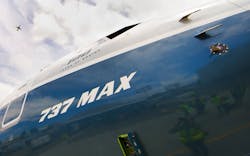FAA Proposes Shielding Boeing Employees Overseeing Safety
Aviation regulators are taking steps to shield U.S. aviation-industry engineers from the kind of pressures that helped lead to the design flaw on the Boeing Co. 737 Max linked to twin fatal crashes.
The Federal Aviation Administration on Monday proposed new policies that would shield employees at Boeing and other planemakers who act in behalf of the federal government to review safety from company pressures.
“New draft guidance calls for manufacturers to monitor, report and investigate all allegations of interference and to report the results to the FAA,” the agency said in a statement. “It also establishes a clear path for these employees to speak freely with FAA certification officials at any time.”
The proposal addresses one of the most controversial issues to emerge from the Max crashes in 2018 and 2019 that killed 346 people: it was Boeing’s own engineers who approved the final design of the system on the jet that led to the crashes, not FAA employees.
The FAA, at times under the direction of Congress, has for decades permitted industry employees known as delegees to review aircraft designs.
But a House Transportation and Infrastructure Committee report on the crashes said the FAA rules allowing company employees to act as deputized representatives for the government was a conflict of interest and contributed to a design flaw in the jet.
A bill passed by Congress in December 2020 known as the Aircraft Certification Reform and Accountability Act didn’t eliminate the practice, but included several provisions requiring changes. Additionally, FAA Administrator Steve Dickson has listed the issue as a priority in how the agency responds to the Max crashes.
The issue of pressure on Boeing workers deputized to act on behalf of the FAA has also prompted fines against the company. Boeing agreed to pay $6.6 million a year ago to settle civil allegations that including pressuring its employees.
A safety system on the Max, an updated version of the 737, pushed the jet’s nose down repeatedly in crashes off the coast of Indonesia and in Ethiopia after similar malfunctions. The plane was grounded worldwide for at least 20 months. The system has since been redesigned to prevent such failures.
___
©2022 Bloomberg L.P. Visit bloomberg.com. Distributed by Tribune Content Agency, LLC.
